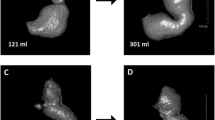Background
Although the efficacy of laparoscopic sleeve gastrectomy (LSG) for morbidly obese patients with a BMI of <50 kg/m2, the incidence of weight gain by change of eating behaviors, and gastric dilatation following LSG have not been investigated thus far, LSG is becoming more common as a single-stage operation for the treatment morbid obesity.
Methods
This is a prospective study of the initial 120 patients who underwent isolated LSG. Initially, the LSG was performed without a calibration tube and resulted in high sleeve volumes (group 1: n=25). In group 2 (n=32), a calibration tube of 44 Fr and in group 3 (n=63) a calibration tube of 32 Fr were used. The study group consists of 101 patients with high BMI who were scheduled for a two-step LBPD-DS, but rejected the second step after 1 year. Study endpoints include estimated sleeve volume, volume of removed stomach, operative time, complication rates, length of hospital stay, changes in co-morbidity, percentage of excess BMI loss (%EBL) and changes in BMI (kg/m2).
Results
All 3 groups were comparable regarding age, gender, and co-morbidities. There was no hospital mortality, but there was one case of late mortality (0.8%). 2 early leaks (1.7%) were seen. % excess BMI loss was significantly higher for patients who underwent LSG with tube calibrations. LSG with large sleeve volume showed a slight weight gain during 5 years of observation. A total of 16 patients (13.3%) underwent a second stage procedure within a period of 5 years (2 redo-sleeves, 7 LBPD-DS, 3 LRYGBP).
Conclusion
Early weight loss results were not different between the groups, but after 2 years the more restrictive LSG (groups 2, 3) results were significantly better than in patients without calibration. A removed gastric volume of <500 cc seems to be a predictor of failure in treatment or early weight regain. A statistically significant improved health status and quality of life were registered for all groups. The general introduction of LSG as a one-stage restrictive procedure in the bariatric field can be considered only if the procedure is standardized and long-term results are available.
Similar content being viewed by others
References
Mendez MA, Monteiro CA, Popkin BM. Overweight exceeds underweight among women in most developed countries. Am J Clin Nutr 2005; 81: 714–21.
Olshansky JF, Passeiro DJ, Hershow RC et al. A potential decline in life expectancy in the United States in the 21st century. N Engl J Med 2005; 352: 1 1135–7.
European Charter on Counteracting Obesity. www.euro.who.int/document/E89567.pdf (accessed January 16, 2007).
Chu CA, Gagner M, Quinn T et al. Two-stage laparoscopic biliopancreatic diversion with duodenal switch: an alternative approach to super-super morbid obesity. Surg Endosc 2003; 16: S069 (abst).
Gastrointestinal surgery for severe obesity. National Institutes of Health Consensus Development Conference Draft Statement. Obes Surg 1991; 1: 257–65.
Weiner S, Sauerland S, Fein M et al. The Bariatric Quality of Life (BQL) Index: A measure of well-being in obesity surgery patients. Obes Surg 2005; 15: 538–45.
Regan JP, Inabnet WB, Gagner M et al. Early experience with two-stage laparoscopic Roux-en-Y gastric bypass as an alternative in the super-super obese patient. Obes Surg 2003; 13: 861–4.
Johnston D, Sue-Ling HM. Surgical treatment of morbid obesity. In: Cushieri A, Giles C, Moosa AR, eds. Essential Surgical Practice. London: Butterworth-Heinemann 1995: 1036–44.
Johnston D, Dachtler J, Sue-Ling HM et al. The Magenstrasse and Mill operation for morbid obesity. Obes Surg 2003; 13: 10–6.
Kotidis EV, Koliakos GG, Baltzopoulos VG et al. Serum ghrelin, leptin and adiponectin levels before and after weight loss: comparison of three methods of treatment — a prospective study. Obes Surg 2006; 16: 1425–32.
Baltasar A, Serra C, Perez N et al. Laparoscopic sleeve gastrectomy: a multi-purpose bariatric operation. Obes Surg 2005; 15: 1124–8.
Melissas J, Koukouraki S, Askoxylakis J et al. Sleeve gastrectomy: a restrictive procedure? Obes Surg 2007; 17: 57–62.
Carmichael AR, Johnston D, Barker MCJ et al. Gastric emptying after a new, more physiological anti-obesity operation: the Magenstrasse and Mill procedure. Eur J Nucl Med 2001; 28: 1379–83.
Sturm K, Parker B, Wishart J et al. Energy intake and appetite are related to antral area in healthy young and older subjects. Am J Clin Nutr 2004; 80: 656–67.
Dornonville de la Cour C, Lindquist A, Egecioglu E et al. Ghrelin treatment reverses the reduction in weight gain and body fat in gastrectomized mice. Gut 2005; 54: 907–13.
Frezza EE. Laparoscopic vertical sleeve gastrectomy for morbid obesity. The future procedure of choice? Surg Today 2007; 37: 275–81.
Ueda K, Gagner M, Milone L et al. Sleeve gastrectomy with wrapping using polytetrafluoroethylene to prevent gastric enlargement in a porcine model. Surg Obes Relat Dis 2007; (Epub ahead of print).
Sjöström L, Nabro K, Sjöstrom CD et al. Effects of bariatric surgery on mortality in Swedish obese subjects. N Engl J Med 2007; 357: 741–52.
Han MS, Kim WW, Oh JH. Results of laparoscopic sleeve gastrectomy (LSG) at 1 year in morbidly obese Korean patients. Obes Surg 2005; 15: 1469–75.
Cottam D, Qureshi FG, Mattar SG et al. Laparoscopic sleeve gastrectomy as an initial weight-loss procedure for high-risk patients with morbid obesity. Surg Endosc 2006; 20: 859–63.
Baltasar A, Serra C, Perez N et al. Re-sleeve gastrectomy. Obes Surg 2006; 16: 1535–8.
Cohen R, Uzzan B, Bihan H et al. Ghrelin levels and sleeve gastrectomy in super-super-obesity (Letter). Obes Surg 2005; 15: 1501–2.
Author information
Authors and Affiliations
Corresponding author
Rights and permissions
About this article
Cite this article
Weiner, R.A., Weiner, S., Pomhoff, I. et al. Laparoscopic Sleeve Gastrectomy — Influence of Sleeve Size and Resected Gastric Volume. OBES SURG 17, 1297–1305 (2007). https://doi.org/10.1007/s11695-007-9232-x
Received:
Accepted:
Published:
Issue Date:
DOI: https://doi.org/10.1007/s11695-007-9232-x




